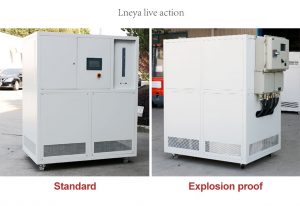New energy power car power battery detection system vacuum description
The new energy power vehicle power battery test checks the vacuum pump switch in the closed state before operation; when the vacuum pump is placed horizontally, ensure that the lubricating oil and the oil level line are kept horizontal; whether the sealing rubber pad is damaged; whether the pressure gauge needle is returned to zero. Place the vacuum pump on the indoor floor (safe, stable, and easy to operate). It is forbidden to be placed outdoors, and it is not allowed to be placed on the power battery test of new energy power vehicles. Combine the fluoridation tube, pressure gauge and vacuum pump, unscrew the nut at the fluorination port from the large valve, screw the fluorotube onto the fluoride port, and confirm whether the thimble is in the top position. (It is forbidden to tighten the joint with tools such as pliers). First open the pressure gauge valve, then open the vacuum pump power switch and start vacuuming.
Observe the pressure gauge (low pressure) when vacuuming. Stop the vacuum after the pressure reaches -0.1 MPa (negative pressure). The vacuuming time should be determined according to the size of the model and the vacuum pump. The reference time is 10 to 30 minutes, not less than 5 minutes. And should be based on the pressure value displayed on the pressure gauge. First close the pressure gauge valve and then turn off the vacuum pump power switch. Remove the fluorinated tube from the vacuum pump and tighten the air pump nozzle cap to prevent dust from entering. After vacuuming, the pressure must be checked after the pressure is maintained. The pressure is not more than -0.08MPa. If the pressure is greater than -0.08 MPa, the cause of the leak should be found. The pressure is not more than -0.08 MPa (a small amount of rebound with a pressure of 0.02 MPa is allowed). If the pressure is greater than -0.08 MPa, indicating that there is a leak, find the cause of the leak and repeat the above procedure after solving it.

The new energy power vehicle power battery test confirms that there is no leak point and then opens the small valve spool. When the pressure (low pressure) reaches 0.1 MPa-0.5 MPa, the small valve is closed. When the pressure gauge pointer does not move, the pressure gauge valve should be opened a little to see if there is gas discharge. If there is no gas discharge, the fluorine tube is not connected with the valve. The thimble of the fluorine tube does not open the top core of the valve. . At this point, the vacuuming operation should be repeated (starting from the fourth step). After confirming the end of the pumping operation, quickly remove the fluoridation tube and pressure gauge, and then re-open the small valve and turn it back half a turn. After fully opening the large valve and turning a half turn, immediately tighten the valve back cover nut to prevent the valve core rubber seal from leaking and tighten the nut.
The vacuum state of the new energy power vehicle power battery test has a certain impact on its operation, so we need to avoid these external factors that affect the new energy power car power battery detection system.
Related recommendations
-
Vocs exhaust gas condensation recovery unit refrigerant charging instructions
1074In the vocs exhaust gas condensation recovery process, the refrigerant is able to affect the operation of the vocs exhaust gas condensation recovery process, vocs exhaust gas condensation recovery treatment professional manufacturers reminded that...
View details -
With these points, the use efficiency of the ultra-low temperature chiller can be more efficient
1038The structure of the ultra-low temperature chiller is more complicated. Its main function is to provide cold air to the product, which is the refrigeration function. If you want to improve the efficiency of the freezer, you must pay attention to t...
View details -
Operation and Maintenance of Small Water Chiller Units
9112. Air-cooled module internal filter, in order to better filter impurities in the water system, the protective plate heat exchanger is generally more than 40 meshes, that is to say, its filter is more dense and finer than other brands. The advanta...
View details -
LNEYA semiconductor component test device design
1079The semiconductor component test device is used for high and low temperature test operation in the semiconductor and component industries. The LNEYA semiconductor component test device utilizes its advantages in the field of refrigeration and heat...
View details
 LNEYA Industrial Chillers Manufacturer Supplier
LNEYA Industrial Chillers Manufacturer Supplier












